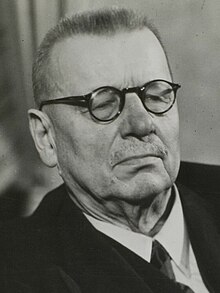
Back يوهو كوستي بآسيكيفي Arabic يوهو كوستى بآسيكيفى ARZ Juho Kusti Paasikivi AST Yuho Kusti Paasikivi Azerbaijani Юха Кусці Паасіківі Byelorussian Juho Kusti Paasikivi Catalan Juho Kusti Paasikivi Czech Juho Kusti Paasikivi Welsh Juho Kusti Paasikivi Danish Juho Kusti Paasikivi German
Juho Kusti Paasikivi | |
|---|---|
 Paasikivi in 1945 | |
| 7th President of Finland | |
| In office 11 March 1946 – 1 March 1956 | |
| Prime Minister | |
| Preceded by | C. G. E. Mannerheim |
| Succeeded by | Urho Kekkonen |
| Prime Minister of Finland | |
| In office 17 November 1944 – 9 March 1946 | |
| President | Gustaf Mannerheim |
| Preceded by | Urho Castrén |
| Succeeded by | Mauno Pekkala |
| In office 27 May 1918 – 27 November 1918 | |
| Preceded by | Pehr Evind Svinhufvud |
| Succeeded by | Lauri Ingman |
| Chairman of the Senate of Finland | |
| In office 27 May 1918 – 27 November 1918 | |
| Preceded by | Pehr Evind Svinhufvud |
| Personal details | |
| Born | Johan Gustaf Hellsten 27 November 1870 Koski Hl, Grand Duchy of Finland, Russian Empire |
| Died | 14 December 1956 (aged 86) Helsinki, Finland |
| Resting place | Hietaniemi Cemetery |
| Political party | Finnish Party (1906–1918) National Coalition Party (from 1918) |
| Spouse(s) | Anna Matilda Forsman (desc.) Allina (Alli) Valve |
| Children | 4 |
| Alma mater | Imperial Alexander University (now University of Helsinki) |
| Profession | statesman, professor, attorney |
| Signature |  |
Preview warning: Page using Template:Listen with missing file "President Juho Kusti Paasikivi's speech on the end of World War 2.ogg" | |
Juho Kusti Paasikivi (Finnish pronunciation: [ˈjuho ˈkusti ˈpɑːsiˌkiʋi], 27 November 1870 – 14 December 1956) was a Finnish politician who served as the seventh president of Finland from 1946 to 1956. Representing the Finnish Party until its dissolution in 1918 and then the National Coalition Party, he previously served as senator, member of parliament (1907–1909, 1910–1914),[1] envoy to Stockholm (1936–1939) and Moscow (1940–1941), and Prime Minister of Finland (1918 and 1944–1946).[2] He also held several other positions of trust, and was an influential figure in Finnish economics and politics for over fifty years.
Paasikivi is remembered as a main architect of Finland's foreign policy after the Second World War;[3] for example, the Paasikivi Society (Paasikivi-seura), founded in 1958 under the leadership of Jan-Magnus Jansson, sought to nurture Paasikivi's political legacy, especially during the Cold War, by promoting 'fact-based foreign policy thinking' in Finland and making Finland's policy of neutrality internationally known.[4]
- ^ J. K. Paasikivi – Eduskunta.fi (in Finnish)
- ^ "Ministerikortisto". Valtioneuvosto. Archived from the original on 2009-04-17.
- ^ Wilsford 1995, pp. 347–352.
- ^ Suomi kylmässä sodassa: Paasikivi-seura Kekkosen tukena Archived 2022-02-08 at the Wayback Machine (in Finnish)